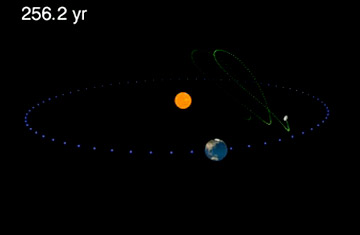
A screen shot from an animation showing the orbit of 2010 TK7 (the green dots), Earth's first-known Trojan asteroid, discovered by NASA's WISE spacecraft
Asteroids have always been the proletariat of the solar system. It's not just that most of them are nothing more than very big rocks, it's that there are so darn many of them — more than a million in the 1-km or larger range. It's hard to get excited about what's little more than a celestial rubble stream.
But asteroids are getting their moment to shine. The Dawn spacecraft just arrived in orbit around Vesta — the second largest asteroid in the solar system — and will later make a similar visit to Ceres, the 900-km-diameter granddaddy of them all. Ceres is so large that it's spherical and has been officially accorded the honorific "dwarf planet," putting it on the same footing as the recently demoted Pluto.
Now there's word out of NASA's Jet Propulsion Laboratory that astronomers have just discovered Earth's first Trojan asteroid — a rock that shares our own solar orbit, leading us around the sun like a tugboat pulling an ocean liner. That's big news not just because such an object had never been spotted before, but also because a Trojan could make such an easy and nifty place for astronauts to visit.
Trojan asteroids have been seen in the solar system before: Mars has one, so does Jupiter, so does Neptune and so do two of Saturn's moons. There was no reason Earth couldn't have one too, but they're not easy to detect because of both their small size and the telescope-swamping effects of the sun. (Through a complicated — and unfortunate — interplay of Trojans' Earth-leading position and the rotation of the planet itself, the asteroids tend to appear in the skies mostly during daylight hours.)
But the Wide-field Infrared Survey Explorer (WISE) spacecraft, launched in 2009, isn't troubled by daylight because, as its name suggests, it sees in the infrared. WISE conducted an extensive scan of the skies from January 2010 to February 2011, and among the flood of data that came back, astronomers found two Trojan candidates — one of which they've just confirmed. The asteroid — known for the moment simply as 2010 TK7 — is about 300 m in diameter and currently leads the Earth by about 80 million km. It sits in a gravitationally quiescent zone known as a Lagrange point, where the pull of the planet Earth and that of the sun effectively balance each other out. Such a spot, for an asteroid, is a little like being dropped into a valley, which means that 2010 TK7 has probably been with us for a very long time and is not going anywhere soon.
That's not to say the rock is completely stable. Indeed, it follows an almost sweeping path above and below the plane of Earth's orbit, and over the next century it will come as close as 24 million km to us. What the asteroid is never projected to do is hit us, which makes its discovery pretty much all upside and no downside — from the perspective of not having to worry about the annihilation of all known life and the planet itself, at least.
But 2010 TK7 is not a place we're ever likely to visit. NASA has been closely studying near-Earth asteroids as possible destinations for astronauts now that the shuttle program is complete, and there's a lot to recommend such a trip. Asteroids are scraps of the primordial solar system — some of the deepest core samples we're ever likely to get of the history of our corner of the galaxy. And the low gravity of asteroids makes them easy to approach, orbit and leave without expending too much fuel. A Trojan, which essentially travels the same orbital autobahn as we do, ought to be one of the best targets of all. But 2010 TK7 would require a lot of chasing to keep up with its swoops and dives above and below the orbital plane; that would require a very powerful engine and a very heavy — and expensive — ship.
The good news is that where one Trojan is, others could easily be, and WISE is not finished looking. A steadier rock may well be out there; if it is, astronauts could eventually be paying it a very close-up visit.
